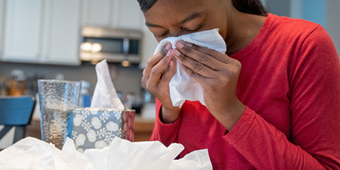7 Tips to Dine Out Safely with Food Allergies

Find Your Perfect Match
Answer a few questions and we'll provide you with a list of primary care providers that best fit your needs.
Don’t let food allergies limit your dining choices! With careful preparation and planning, you can still enjoy the fun of eating out.
These recommendations from the Food Allergy Research & Education (FARE) organization can help you plan for a safe dining out experience. You can even modify some of these ideas when you eat at the homes of family and friends.
1. Choose a Restaurant Carefully
- Ask for recommendations from your allergist or from friends with food allergies. Check the restaurant’s website or visit the SafeFARE
 website, which has tools to research restaurant menus in advance.
website, which has tools to research restaurant menus in advance. - Pick a restaurant that best fits what you can eat. Avoid these riskier choices:
Buffets: With a wide variety of foods laid out so close to one another, buffets have a high risk of accidental exposure and cross-contact.
Bakeries: These also have a high risk of cross-contact since many items are made with some of the top eight allergens, and they’re not usually packaged.
Restaurants serving pre-made foods: Here the staff may not have an accurate list of ingredients in a pre-made item. With dishes not prepared from scratch, the chef can’t remove a problem ingredient from an item.
Restaurants known to use allergens in dishes: For instance, peanuts and other nuts are often used in Asian cuisines. In ice cream parlors, shared scoops increase the risk of cross-contact. Obviously, if you have a fish or shellfish allergy, avoid seafood restaurants. - Consider chain restaurants, especially when traveling. Each restaurant is likely to use the same ingredients and prepare foods the same way. A growing number are allergy-aware.
- If you plan to attend a catered event where the food will be prepared in advance, ask for an allergy-friendly option.
2. Plan Ahead
- Call and ask to speak to a manager. See below for tips on what questions to ask.
- Eat early: Choose a day and time when the restaurant kitchen is not as busy, preferably during the first hour of a service period when the staff is more alert and the kitchen cleaner.
- Bring along a chef card
 . On this wallet-sized card, you specify your food allergies and state that your food must be cooked in a clean and safe area to avoid cross-contact. The card is available in template form in English as well as in nine other languages.
. On this wallet-sized card, you specify your food allergies and state that your food must be cooked in a clean and safe area to avoid cross-contact. The card is available in template form in English as well as in nine other languages. - Always bring your medicines (epinephrine auto-injector and the like) in case you do have an allergy attack. Wear your medical identification bracelet.
3. What to Ask
- Are you willing to accommodate me in your restaurant? If yes, provide them with as much information about your food allergies or special diets as possible. Make sure they understand how serious an allergic reaction can be.
- How often do you train your staff on food allergies? In the food industry there is constant employee turnover, and you don’t want a new employee who hasn’t been properly trained handling your requests.
- Do you have a separate area to prepare foods for special diets? If yes, ask them what foods are prepared there. There may be hidden allergens used in this area.
- Do you have separate cutting boards and utensils with which to prepare my meal? Several companies make color-coded tools for safe food preparation for people with food allergies. If chefs use these tools, it shows the restaurant has an understanding of food allergen safety procedures.
- Do you have any specialty products for people with food allergies? These include prepared mixes, rice milk, or packaged snacks or desserts that are from trusted manufacturers. They show that this restaurant is aware of planning for food allergies.
- Will I be able to look at ingredient labels? If they are willing to show you ingredient labels, it’s a good sign that the restaurant will be accommodating.
- Will you be at the restaurant while I am there? If not, request the name of the manager or staff member who is aware of the circumstances.
Call between meal hours and not during peak breakfast, lunch or dinner times — ideally between 2 and 4 p.m. — when restaurants aren’t as busy and a manager or chef can speak with you. If neither is available, ask for the appropriate name and find out the best time to call back. Be ready with your list of questions. Here are some suggestions for what to ask:
4. Your Talking Points
Provide the manager or chef with a list of your food allergies, and tell them what you usually eat when you dine out. The chef should be able to create a menu item to fit your needs.
Discuss cooking preparation. Sautéed or baked items minimize the use of common cooking equipment and shared utensils. Go through the list of ingredients being used in your dish, including garnishes, to ensure there are no hidden allergens.
Once you have both agreed on your meal, write it down and take this information with you to the restaurant. Tell the manager or chef when you plan on dining to make sure he or she will be there.
5. When You Arrive
Remind the restaurant manager, chef and wait staff that you have food allergies. Present your chef card and ask that it be shown to the chef.
Since you called ahead to let the restaurant know about your allergy, ask if there is a notification of your allergy or special diet on your reservation. If yes, it shows that your information was properly communicated. If not, this could be a red flag, but don’t give up. Ask them to inform the manager that you would like to talk to him or her when you’re seated.
Consider chain restaurants, especially when traveling. Each restaurant is likely to use the same ingredients and prepare foods the same way.
Ask the waiter what is in your dish and how it’s prepared. Make sure your server understands what you are allergic to; explain that cross-contact must be avoided. Don’t be embarrassed — if the wait staff doesn’t get your situation, seek out another staff member or manager.
Even if the server tells you they’re aware of your dietary request, still speak with the manager or the chef to ensure the right information is getting to the kitchen. Present the written menu option you discussed when you called. If the manager seems genuinely concerned, go over your request in detail. Ask if the manager can personally handle your food so that there are no mistakes.
6. Select a Simple Meal
Keep it simple. Ordering basic fare — like a baked potato, broiled chicken or steamed vegetables — can be the safest way to go.
Avoid fried foods unless you know they are prepared safely. The grill and frying oil are both rife with cross-contact.
Be careful when ordering desserts, often a source of hidden allergens. Since many restaurants order their desserts from specialty shops, the staff may not be able to provide a list of ingredients. If in doubt, wait and have a safe dessert at home.
7. Pay Attention and Reward Good Service
When you arrive at your table, check the cleanliness of the table and chairs. It’s essential that your seating area is clean and sanitized, particularly if you have ever had a reaction from touching your allergen.
Servers should not prepare any part of your meal. Server areas can be very busy with many servers working on a variety of orders at the same time. Ladles and tongs used for serving soups and salad ingredients can be inadvertently placed back with the wrong food. This will cause your meal to come in contact with other foods to which you may be allergic.
When your meal is delivered, make sure the person who delivers it is someone you’ve spoken with — your server, a manager or the chef. If not, ask for a manager to double-check your order. This person may have inadvertently picked up the wrong food.
Your plate should be delivered separately. Many restaurants teach the technique of “plate stacking,” where the plates are balanced on the server’s arm and delivered to the table. You do not want your plate next to another guest’s plate that might contain an allergen.
Confirm your order. Have them describe how your meal was prepared and listen for anything unusual. Did they mention an ingredient or cooking technique that was not discussed earlier?
Look at your plate. Are there any garnishes? Is the item cooked correctly? If anything looks wrong, ask questions. You need to assess the situation and make the final decision. If anything is wrong and you feel uncomfortable, send the food back.
If you do have a good experience at a restaurant, tell the staff about it and be a repeat customer. Reward excellent service and build a relationship.
Find Your Perfect Match
Answer a few questions and we'll provide you with a list of primary care providers that best fit your needs.
Source: Food Allergy Research & Education




